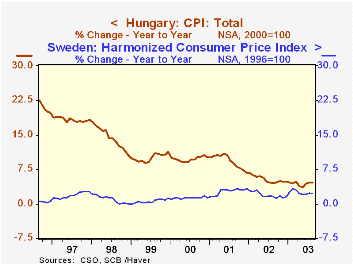 Global| Sep 11 2003
Global| Sep 11 2003CPIs Converge as Economies Open
Summary
Inflation in Europe remains fairly steady, according to August CPI reports released this morning by four diverse countries. 12-month rates of change for France, Spain and Sweden are all hovering within the ranges that have prevailed [...]

Inflation in Europe remains fairly steady, according to August CPI reports released this morning by four diverse countries. 12-month rates of change for France, Spain and Sweden are all hovering within the ranges that have prevailed the last several years. Inflation in Hungary, while showing little recent movement and still noticeably higher than in the other more established market economies, still appears to be working its way lower. Its convergence with the CPI in, for example, Sweden, is obvious in the nearby graph. This would be expected as a consequence of the larger trade and capital flows that developed with the opening of the Hungarian economy in the early 1990s.
History is brief for the components of Hungary's CPI, but since 1999, inflation in housing, health care, hospitality services and alcohol has been consistently higher than the total CPI. Clothing, furniture and communications have run lower. The latter comparison looks to be a fairly widespread; among these particular countries, all three segments have restrained inflation in Spain and Sweden, although their performance has varied France. On the up-side, inflation-contributing sectors vary by country. Housing and health care have been higher than overall inflation in Sweden, but not in Spain.
Thus, sources of inflationary pressure have generally differed among the countries, but disinflationary tendencies are more uniform. Since the US has also seen price weakness in clothing, household furniture and communications sectors, one might conclude that certain factors apply fairly broadly: greater productivity and competition are keeping prices down for the key consumer goods categories, while technology has reduced communications costs. Segments where there is less competition and less technological input, such as housing and health care, tend to have more upward bias and less uniformity in their price trends.
| CPI in Selected Countries (% Changes) | August 2003 (Y/Y) | July 2003 (Y/Y) | June 2003 (Y/Y) | Dec/Dec
|---|---|---|---|
| 2002 | 2001 | 2000 |
| France | 2.0 | 1.9 | 1.9 | 2.2 | 1.4 | 1.7 | |
|---|---|---|---|---|---|---|---|
| Spain | 3.1 | 3.1 | 3.2 | 2.9 | 3.3 | 3.3 | |
| Sweden | 2.2 | 2.4 | 2.0 | 1.7 | 3.2 | 1.3 | |
| Hungary | 4.7 | 4.7 | 4.3 | 4.8 | 6.8 | 10.1 |
Carol Stone, CBE
AuthorMore in Author Profile »Carol Stone, CBE came to Haver Analytics in 2003 following more than 35 years as a financial market economist at major Wall Street financial institutions, most especially Merrill Lynch and Nomura Securities. She had broad experience in analysis and forecasting of flow-of-funds accounts, the federal budget and Federal Reserve operations. At Nomura Securities, among other duties, she developed various indicator forecasting tools and edited a daily global publication produced in London and New York for readers in Tokyo. At Haver Analytics, Carol was a member of the Research Department, aiding database managers with research and documentation efforts, as well as posting commentary on select economic reports. In addition, she conducted Ways-of-the-World, a blog on economic issues for an Episcopal-Church-affiliated website, The Geranium Farm. During her career, Carol served as an officer of the Money Marketeers and the Downtown Economists Club. She had a PhD from NYU's Stern School of Business. She lived in Brooklyn, New York, and had a weekend home on Long Island.





